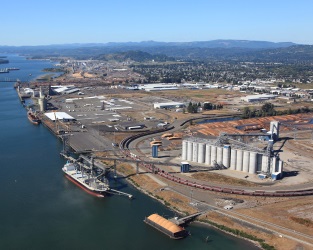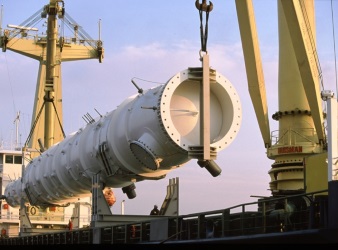
| July 8, 2014 | |
Cargo Trends: Central/South America, Longview, Port Manatee
![]() Print this Article | Send to Colleague
Print this Article | Send to Colleague
Central and South American container port traffic grew in 2013, but barely so, inching upward 1.4 percent to a near-record 31.7 million TEUs. The Port of Longview handled a record 7.4 million metric tons in 2013, up 18 percent from 6.3 million tons in 2012. Port Manatee’s booming international trade will get a big boost next year when Air Products begins exporting liquefied natural gas heat exchangers.
Central and South America: Port Container Traffic 2013
Central and South American container port traffic grew in 2013, but barely so, inching upward 1.4 percent to a near-record 31.7 million TEUs. That followed the 1.6 percent decline of the previous year, but significantly less robust than the double-digit gains of earlier years.
These are conservative numbers, representing the throughput of more than 80 ports in 16 countries. Data are incomplete or unavailable for Belize, Guyana, French Guiana, and Paraguay. Sources included individual seaport authorities, the Economic Commission for Latin America and the Caribbean, Brazil’s Agência Nacional de Transportes Aquaviários, and Autoridad Marítima de Panamá.
In Central America, throughput fell 0.8 percent to 9.98 million TEUs, due entirely to a 3.8 percent decline in the region’s dominant container handler and international transshipment hub, Panamá. Substantial increases were posted by Costa Rica, El Salvador, Guatemala, Honduras, and Nicaragua. In South America, container traffic set a record, 23.7 million TEUs, and a year-on-year increase of 2.4 percent. Brazil posted a 9.0% increase and a nearly 38% share of the South American port container traffic market. Also in the plus column were Chile (+4.7 percent), Perú (+1.8 percent), Suriname (+3.9 percent), and Uruguay (+9.7 percent). Data by region and country for the years 2004-2013 are summarized in the first attachment.
In 2013, Santos (Brazil) ranked first among the container ports of Central and South America with throughput at an all-time high of 3.4 million TEUs, followed by Balboa (Panama) at nearly 3.1 TEUs. Based on 2013 TEU throughput, Santos and Balboa rank fourth and fifth in the Western Hemisphere, after Los Angeles, Long Beach, and New York & New Jersey.
Other Central and South American ports handling a million TEUs or more in 2013 were Colon (Panamá), Cartagena (Colombia), Buenos Aires (Argentina), Callao (Perú), Guayaquil (Ecuador), San Antonio (Chile), Itajaí/Navagante (Brazil), and, for the first time, Limón/Moin (Costa Rica). The second attachment presents a ranking of the region’s top 40 container ports.
Approximately 25 ports region-wide posted double- and in some cases, tripled-digit increases over 2012. Among the top performers were Acajutla (El Salvador), Arica (Chile), Bahía Blanca (Argentina), Coronel (Chile), Fortaleza (Brazil), Itapóa (Brazil), Zarate (Argentina), Rosario (Argentina), Puerto Madryn (Argentina), Puerto Castillo (Honduras), Puerto Barrios (Guatemala) and San Antonio (Chile). For a detailed profile of container traffic by country and port, refer to the third attachment.
Longview Has Banner Cargo Year in 2013
The Port of Longview handled a record 7.4 million metric tons in 2013, up 18 percent from 6.3 million tons in 2012 thanks in part to soaring demand for logs in Asia and solid gains for grain and steel.
In detail, the data, as reported by the port, show, log exports skyrocketed 62 percent to 858,000 tons from 531,000 tons, while steel imports surged 47 percent, "mostly due," says the port, to a "drastic reduction" in U.S. tariff rates on imported steel. Bulk cargos continued to play a large role at the port in 2013, with upticks in salt, calcined coke, wheat, soybeans, talc and soda ash. Grain exports from Longview’s EGT facility rose by nearly 10 percent to 5.15 million tons.
Despite the tonnage gains, the port experienced a 6 percent drop in operating revenue, from $33.8 million in 2012 to $31.7 million last year. The port’s revenue is derived mainly from cargo handling fees, with just 4 percent coming from property rentals. Net operating income (before depreciation) amounted to $6.7 million in 2013.
The port attributes the revenue drop to fluctuations in cargo markets. Wind energy cargo and iron oxide fines, which the port handled large quantities in 2012, dropped to zero in 2013. Additional cargos were impacted as customers switched to sourcing cargo domestically and by weather-curtailed crop production.
"Overall, the port had another great year," said Port CEO Geir-Eilif Kalhagen. "We reinvest revenues right back into the Port so we may continue providing strong infrastructure for our customers and economic benefits for our community."

Port Longview from the air showing the EGT export elevator in the immediate
foreground with the white silos and conveyors leading to the grain ship at
Berth 9 and a barge discharge cargo just upstream.
Photo/Port of Longview
Port Manatee Trade Jumps, Further Growth Anticipated
Port Manatee’s booming international trade will get a big boost next year, when Air Products begins exporting liquefied natural gas heat exchangers from the port.
Data cited by the port authority show Manatee’s international trade amounted to $257.57 million through the first four months of 2014. That was up 17.2 percent from a year ago, reflecting increases of 25.7 percent for exports and 14.3 percent for imports.
"Port Manatee’s trade growth thus far this year is impressive indeed," said Port Executive Director Carlos Buqueras. "Even more encouraging is the fact that Port Manatee’s export figures are poised to begin to increase exponentially next year, when shipment begins of LNG heat exchangers made at the Air Products Port Manatee facility."
Florida Gov. Rick Scott was on hand in January when the liquefied natural gas technology and equipment supplier dedicated its new 300,000-square-foot facility on 32 acres immediately across U.S. 41 from Port Manatee’s gates.
Port Manatee is taking steps to ensure its readiness to accommodate burgeoning volumes. It has opened its 40-foot-draft Berth 14, which, combined with Berth 12, offers 1,600 feet of contiguous berthing area adjacent to its 52-acre South Port property, where 10 acres already are developed and where a roll-on/roll-off terminal and vehicle-processing facility are targeted for development under a memorandum of understanding with The Pasha Group. Most recently, port officials announced June 10 plans for an international trade hub at the Port Manatee Intermodal Center.
"With Port Manatee’s propitious position as the closest U.S. deep-water seaport to the expanding Panama Canal and as a natural gateway for Cuba trade," Mr. Buqueras said. "We are readying for off-the-charts growth in commerce, furthering our already impressive contribution to the Manatee County economy."

Air Products will begin exporting natural gas heat exchangers such as this one
from its Port Manatee in 2015.
Photo/Port Manatee
